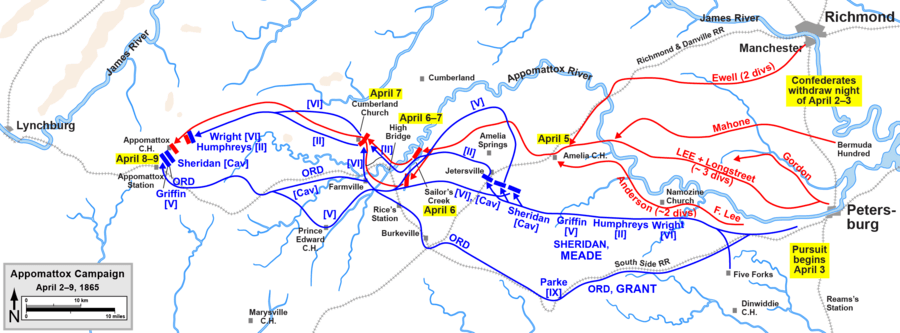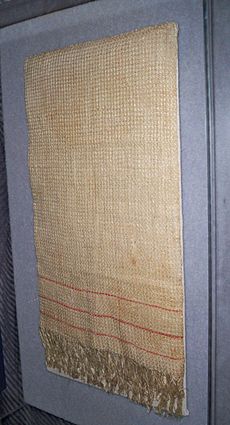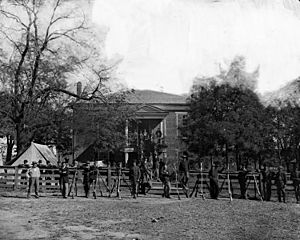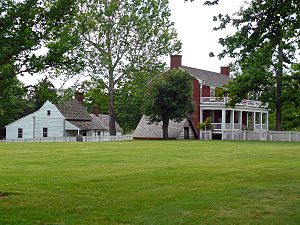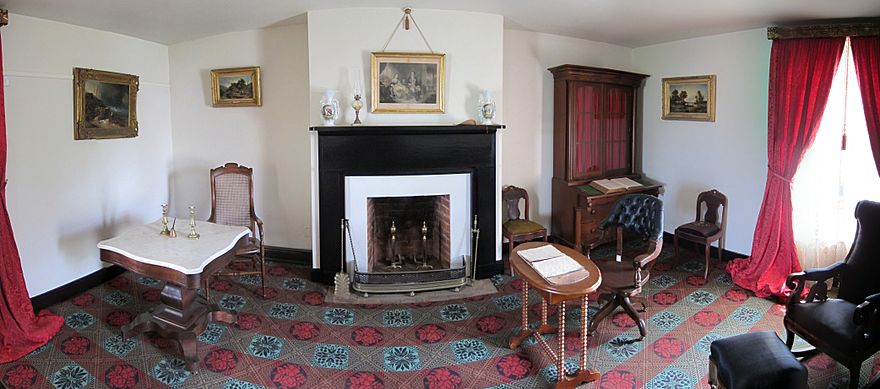Battle of Appomattox Court House facts for kids
Quick facts for kids Battle of Appomattox Court House |
|||||||
|---|---|---|---|---|---|---|---|
| Part of the American Civil War | |||||||
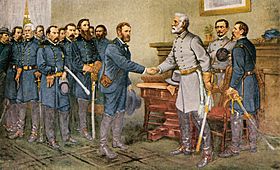 A print showing Ulysses S. Grant, Commanding General of the Union Army, accepting Confederate General in Chief Robert E. Lee's surrender on April 9, 1865 |
|||||||
|
|||||||
| Belligerents | |||||||
| Commanders and leaders | |||||||
| Ulysses S. Grant Thomas M. Harris George G. Meade Philip Sheridan Edward O.C. Ord |
Robert E. Lee Henry L. Benning John Gordon |
||||||
| Units involved | |||||||
| Army of the Potomac Army of the Shenandoah Army of the James |
Army of Northern Virginia |
||||||
| Strength | |||||||
| 63,285 | 26,000 | ||||||
| Casualties and losses | |||||||
| 164 killed or wounded | 195 killed 305 wounded ~26,000–28,000 surrendered and paroled (see text) |
||||||
The Battle of Appomattox Court House was one of the very last battles of the American Civil War (1861–1865). It happened in Appomattox County, Virginia, on the morning of April 9, 1865. This battle was the final fight for Confederate General Robert E. Lee and his Army of Northern Virginia. They surrendered to the Union Army of the Potomac, led by General Ulysses S. Grant.
General Lee had left the Confederate capital of Richmond, Virginia. He hoped to meet up with other Confederate forces in North Carolina. But Union soldiers, especially cavalry led by General Philip Sheridan, chased Lee's army. They cut off his escape route near the village of Appomattox Court House.
Lee tried one last attack to break through the Union lines. He thought only lightly armed cavalry were in front of him. But he soon saw that two large groups of Union infantry (foot soldiers) were also there. With his escape blocked, Lee had no choice but to surrender.
The surrender papers were signed in the home of Wilmer McLean on the afternoon of April 9. A few days later, on April 12, there was a formal ceremony. Confederate Major General John B. Gordon led his soldiers to surrender their weapons to Union Brigadier General Joshua Chamberlain. About 28,000 Confederate soldiers were allowed to go home. They could not take their main weapons, but they could keep their horses and officers could keep their sidearms. This event effectively ended the war in Virginia.
Lee's surrender led to other Confederate armies giving up across the South. This included forces in North Carolina, Alabama, and Louisiana. By June, the four-year-long war was officially over.
Contents
Why the Battle of Appomattox Happened
The War's Final Campaign
The last major campaign for Richmond, Virginia, the capital of the Confederacy, began in June 1864. Union armies, led by General Ulysses S. Grant, surrounded Petersburg, Virginia. Petersburg was south of Richmond. Grant wanted to cut off supplies to both cities. This would force the Confederates to leave.
By spring 1865, Confederate General Robert E. Lee knew his army could not hold Petersburg much longer. Union troops made the first big move. On April 1, 1865, Union cavalry led by Major General Philip Sheridan attacked Lee's army from the side at the Battle of Five Forks. The next day, Grant's army broke through the Confederate lines. This ended the long Siege of Petersburg. Lee's soldiers had to leave their trenches, which they had held for ten months. They evacuated on the night of April 2–3.
Lee's Retreat and Grant's Pursuit
Lee's first goal was to gather supplies at Amelia Courthouse. He planned to meet General Joseph E. Johnston's army in North Carolina. Then they would go on the attack. But when Lee's troops reached Amelia on April 4, there were no supplies. Lee had to send wagons to find food. This made him lose a day of marching.
The army then headed west to Appomattox Station. More supplies were supposed to be waiting there. Lee's army was now much smaller. It had only cavalry and two small groups of infantry.
On the way to Appomattox Station, on April 6, a large part of Lee's army was cut off. This happened at the Battle of Sailor's Creek. Union cavalry and infantry captured or forced the surrender of about 7,700 Confederates. This included several Confederate generals. This delay kept Lee from reaching Appomattox Station until late on April 8. Union General Sheridan got there first. He captured Lee's supplies and blocked his path.
After some smaller battles, General Grant sent a note to Lee on April 7. He suggested it was time for Lee to surrender. Lee refused but asked about Grant's terms. On April 8, Union cavalry destroyed three supply trains waiting for Lee at Appomattox Station. Now, both of Grant's main armies were closing in on Appomattox.
Lee's supplies at Appomattox were gone. He now looked west to Lynchburg, Virginia, where more supplies waited. But Union cavalry was the only thing between Lee and Lynchburg. Lee hoped to break through the cavalry before more Union foot soldiers arrived.
Union infantry was close behind Sheridan's cavalry. One group, the XXIV Corps, marched 30 miles in 21 hours to reach the cavalry. General Edward Ord, who led the Army of the James, arrived with them around 4:00 a.m. Sheridan placed his cavalry divisions along a low ridge southwest of Appomattox Court House.
The Battle on April 9
Confederate Attack and Union Response
At dawn on April 9, 1865, Confederate soldiers under Major General John B. Gordon attacked Sheridan's cavalry. They quickly pushed back the first Union line. The next Union line slowed the Confederate advance. Gordon's troops charged through and took the ridge. But when they reached the top, they saw a huge line of Union infantry waiting.
Lee's cavalry saw these Union forces and quickly rode away towards Lynchburg. Union troops began moving against Gordon's soldiers. Another Union group moved against Lieutenant General James Longstreet's corps. A staff officer asked Gordon how his troops were doing. Gordon replied, "Tell General Lee I have fought my corps to a frazzle, and I fear I can do nothing unless I am heavily supported."
When Lee heard this, he finally said what was clear: "Then there is nothing left for me to do but to go and see General Grant." Many of Lee's officers agreed that surrendering was the only choice.
Lee decided to ask for a stop to the fighting. He wanted to learn what surrender terms Grant would offer. A white dish towel was used as a flag of truce. It was carried by one of Longstreet's officers to General Custer's lines. A truce was arranged.
The Meeting of Generals Lee and Grant
At 8:00 a.m., Lee rode out to meet Grant. Grant received Lee's letter that morning. He said his headache seemed to disappear when he read it. Grant's reply let Lee choose where they would meet. Lee sent an aide, Charles Marshall, to find a good spot.
Marshall chose the 1848 brick home of Wilmer McLean. McLean had moved to Appomattox to escape the war. It was ironic that the war would end in his sitting room. Gunshots were still heard as Lee received Grant's message. After several hours of letters, a cease-fire was put in place. Grant then received Lee's request to discuss surrender terms.
Lee waited for Grant in his best white uniform. Grant arrived in a muddy, simple uniform. It was the first time the two generals had seen each other in almost twenty years. Grant felt sad and found it hard to start the meeting. They talked briefly about their only other meeting during the Mexican–American War. Lee brought the conversation back to the surrender. Grant offered the same generous terms he had before.
Terms of Surrender

Grant's terms were very fair. Lee's soldiers would not be put in prison or charged with treason. Officers could keep their sidearms, horses, and personal items. Grant also let the soldiers take their horses and mules home. This was so they could do their spring planting. He also gave Lee's starving army food rations. Lee said this would make his men very happy and help bring the country back together.
The surrender terms were written down by Grant's aide, Ely S. Parker. Parker was a Native American from the Seneca tribe. The document was finished around 4 p.m. on April 9. When Lee saw Parker was a Seneca, he said, "It is good to have one real American here." Parker replied, "Sir, we are all Americans."
As Lee left the house, Grant's men started cheering. But Grant quickly stopped them. He said, "The Confederates were now our countrymen, and we did not want to exult over their downfall."
The Formal Ceremony
On April 10, Lee gave his farewell address to his army. A group of six men met to plan a formal surrender ceremony. Brigadier General Joshua Chamberlain was chosen to lead the Union side.
On April 12, 1865, the Army of Northern Virginia marched to surrender their weapons and flags. Chamberlain later wrote about this moment. He decided to salute the Confederate soldiers as they passed. He felt it was a salute to their bravery, not to their cause. He wrote that his soldiers gave a "soldier's salutation" as the Confederates marched by.
Confederate General John Brown Gordon remembered this salute. He said Chamberlain "called his troops into line, and as my men marched in front of them, the veterans in blue gave a soldierly salute to the vanquished heroes." Gordon called Chamberlain "one of the knightliest soldiers of the Federal army."
About 28,000 Confederate soldiers surrendered and were allowed to go home. This number does not include the 7,700 who were captured at Sailor's Creek a few days earlier. Those men were treated as prisoners of war.
What Happened Next
Even after Lee's surrender, about 175,000 Confederate soldiers were still fighting. But most were starving and losing hope. Many were scattered in small groups. Others were in three main Confederate armies. Just as one officer had predicted, when news of Lee's surrender spread, other Confederate commanders realized the war was lost. They decided to surrender too.
General Joseph E. Johnston's army in North Carolina surrendered to Major General William Tecumseh Sherman on April 26, 1865. This was the largest surrender of the war, with 98,270 Confederate troops. It marked the real end of the conflict. General Richard Taylor surrendered his army in Alabama and Mississippi on May 4, 1865.
Confederate President Jefferson Davis met with his cabinet for the last time on May 5, 1865. He officially ended the Confederate government. Davis was captured by Union forces on May 10 in Georgia.
General Nathan Bedford Forrest also surrendered on May 9, 1865. General Edmund Kirby Smith surrendered the last major Confederate department on June 2, 1865, in Texas. Cherokee Chief and General Stand Watie surrendered the last organized Confederate force on June 23, 1865, in Oklahoma.
There were a few small battles after Lee's surrender. The Battle of Palmito Ranch in Texas on May 12–13, 1865, is often seen as the final land battle. The last Confederate to surrender was Commander James Iredell Waddell. He was on the ship CSS Shenandoah far away in the Pacific. He lowered the Confederate flag in Liverpool, England, on November 6, 1865, after learning the war had ended.
Lee never forgot Grant's kindness during the surrender. For the rest of his life, he would not let anyone speak badly about Grant in front of him. General Longstreet also spoke well of Grant. He was thankful for Grant's friendly greeting and a cigar at Appomattox. Grant later helped Longstreet get a pardon and a job after Grant became president.
Images for kids
-
A print showing Ulysses S. Grant, Commanding General of the Union Army, accepting Confederate General in Chief Robert E. Lee's surrender on April 9, 1865
See also
 In Spanish: Batalla de Appomattox para niños
In Spanish: Batalla de Appomattox para niños


